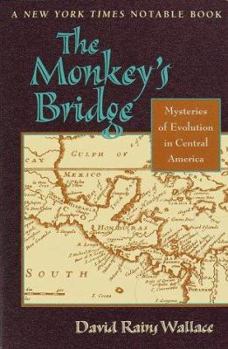Monkey's Bridge: Mysteries of Evolution in Central America
Select Format
Select Condition 
Book Overview
Looks at the impact of the land bridge between North and South America on animal evolution, and describes the species found in Central America today. This description may be from another edition of this product.
Format:Paperback
Language:English
ISBN:1578050189
ISBN13:9781578050185
Release Date:January 1999
Publisher:Sierra Club Books for Children
Length:288 Pages
Weight:0.90 lbs.
Dimensions:0.8" x 6.0" x 9.0"
Customer Reviews
1 rating
A great start to understanding the Central American tropics
Published by Thriftbooks.com User , 26 years ago
Reviewed for The Wilderness Record, publication of the California Wilderness Coalition. Most California environmentalists are familiar with the works of David Rains Wallace, having read his award-winning The Klamath Knot, the superb natural history of the greater Siskiyou region, or The Turquoise Dragon, an enchanting eco-thriller that takes the reader from the Bay Area to the Trinity Alps and Kalmiopsis wilderness areas. If you enjoyed these or a dozen other of his books, you will appreciate The Monkey's Bridge. Wallace's latest natural history treatise looks at the region that linked North and South America some three million years ago and the amazing mix of flora and fauna that surged back and forth across this land bridge. His knack for bringing an region to life makes it a delight to learn about hundreds of species, volcanoes, plate tectonics, and gomphotheres. But Wallace tells more of the story than just the natural history. He begins with the adventurers who sailed from Europe and conquered some, but definitely not all of the native peoples of Central America. Next are those trying to find a shortcut from the Alantic to the Pacific, including the French attempt to build a canal at a cost of an estimated 22,000 lives. He then brings in the naturalists, from those with the first explorers to Charles Darwin and Alfred Russell Wallace. Much of the story is embedded in geology. The fossil record in North and South America led evolutionists to recognize the importance of this land bridge, and the revolutionary theory of plate tectonics gave us the mechanism to explain how the bridge formed. But what really brings this book alive is that Wallace has been there, from his first three-month journey in 1971, a return in 1987 for a "gaudy bird-watching trip," and repeat visits during the last decade. He climbs the volcanoes, claws through the dense rain forests, and snorkels the coral reefs. "Big marine toads plopped in and out, acorn woodpeckers called 'Kraaaa! Kraaa' in the pines, and a flock of parakeets flew shrieking overhead," he colorfully writes. As you surely imagine, this is not a totally happy tale. Wallace discusses the "island ecology" theories of habitat fragmentation and loss of species. He mentions the recent extinction of the flightless, grebe-like poc and the golden toad and recounts the decline of the harpy eagle. But he also describes efforts to reverse this loss of habitat through programs like Paseo Pantera ("the path of the panther") that is a major element of The Wildlands Project's strategy to protect the biodiversity of the North American continent. Wallace clearly is in awe of the complexity and diversity of the Central American rain forest. "Sometimes I think the human language, or simply human mentality, hasn't evolved yet to the point where tropical rain forest is comprehensible or describable," he writes. But with The Monkey's Bridge, Wallace has made a great start.





